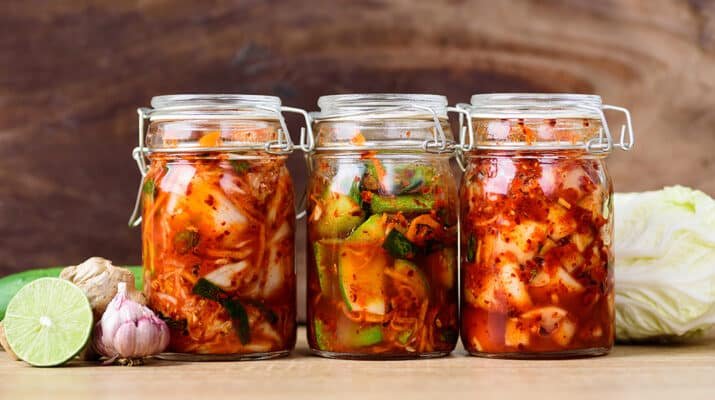The spicy, tangy Korean condiment offers surprising health benefits
By Deborah Jeanne Sergeant
Have you tried kimchi? Commonly used in Korean cuisine — it’s been called “Korean catsup” — the condiment provides a few health plusses. Want to improve your gut health? Kimchi can help with that.
“It’s a fermented food so it has live bacterial cultures which have been proven to be beneficial to our digestive tract,” said Kelly Springer, registered dietitian and owner of Kelly’s Choice in Skaneateles. “By replacing and adding to our gut microbiome, we have the ability to boost our immune system, produce serotonin levels for our neurotransmitter and produce key vitamins like B12, K2.”
Although probiotic supplements are available, kimchi is among the foods that have naturally occurring probiotics, including yogurt, sauerkraut and kefir.
The gut has been called the “second brain” for its interaction with other bodily systems and the connection between emotions and the gut. For example, some people experience an upset stomach while feeling anxious.
The gut is also considered an important part of the immune system. Maintaining healthy gut flora is essential for its normal function. Unfortunately, typical Americans eat foods that sabotage the gut flora, such as sugar, white flour and other highly processed foods, with too few vegetables.
“The other thing kimchi has is it’s also a fiber source, which is a prebiotic,” Springer said. “It is what feeds our gut bacteria. So, if you’re putting in live cultures, they need something to eat. It’s a pre- and probiotic. When we have fiber rich sources, this helps produce the mucosal layer which creates a barrier to protect against viruses and bacteria from entering in. That mucosal layer is the ‘house’ for the probiotics. It’s really interesting to see how they work in a symbiotic relationship. That’s how probiotics and prebiotics affect our immune system, serotonin and vitamins.”
Since kimchi recipes call for cabbage, radish or cucumber, it’s rich in fiber, which is also helpful for bowel movements, both for easing constipation and for developing firmer stools for those with chronic diarrhea. The fiber in kimchi provides food for the probiotics to help them flourish.
Kimchi is not without its drawbacks. It can produce gas because it is made of fermented vegetables. The rich, garlicky odor can be offensive to some. It’s also strongly flavored with Korean fish sauce and the fermentation smell.
The Korean red pepper flakes provide a distinctive taste; but it may be too spicy for some people. But choosing a “mild” variety can help mitigate this effect without compromising its health benefits.
Springer advised trying just half a cup at a time or less at first and more once it’s well-tolerated. Eating it with protein and healthful fat can help, such as on an omelet or in a soup.
In addition to its benefits to gut health, “scientific scrutiny reveals that kimchi is replete with essential nutrients including vitamins A, B, and C, alongside minerals such as potassium, calcium and selenium,” said Canastota-based Laurel Sterling, registered dietitian with Carlson Labs. “Furthermore, it boasts a high concentration of dietary fiber while remaining low in calories. The cardiovascular benefits of kimchi consumption have been noted with its capacity to modulate lipid profiles and oxidative stress, thereby potentially mitigating risk factors associated with heart disease.”
Sterling warned that kimchi is fermented, which may not be recommended for people with compromised immune systems and that kimchi can be high in sodium. Look for brands that contain moderate levels. Because kimchi recipes vary so much, try brands and styles until you find one you like. Or you can make your own.

“It’s wonderful to make at home and easy, too,” said Randy Worobo, professor and food microbiologist in the Department of Food Science at Cornell University.
That may also help you control the amount of sodium in the finished product.
Worobo said that a “younger” Kimchi — one that has not been aged very long — “is not as strong flavored and not as active.”
“Pair it with barbecue meat and rice. It is complementary to those foods. Initially, try it in smaller amounts. You can cut it into smaller pieces instead of the usual two-inch pieces,” he added.
He recommends the websites Korean Bap Sang (www.koreanbapsang.com/) and Maangchi (www.maangchi.com)
“They give really good recipes on how to make kimchi and how to use it,” Worobo said. “For kids, it’s a good project to show them how fermentation works. Kids are more willing to try foods they’re involved in making.”
The spice level doesn’t affect its healthfulness. So it’s OK to go with a milder variety.

